Indigenous People of Australia and Law: Comparative Jurisdictions
VerifiedAdded on 2022/11/25
|11
|2482
|317
Essay
AI Summary
This research essay explores the legal rights of Indigenous people in Australia, focusing on the effectiveness of current protections and comparing them to approaches in New Zealand (Maori seats) and the Nordic countries (Sami Parliaments). The essay delves into relevant domestic law, cases (such as Mabo v Queensland (No.2)), international law, and treaties to assess whether Australia should adopt similar models or pursue alternative strategies. It examines the role of customary law, the Native Title Act 1993, and the application of Australian criminal laws to Indigenous people. Furthermore, the essay analyzes the effectiveness of existing legislation, such as the Victorian Equal Opportunity and Human Rights Commission, and the Aboriginal Customary Law, while considering the challenges in balancing Indigenous rights with the broader community's interests. The research concludes with a critical analysis of the current Australian legal framework and suggests potential improvements by drawing comparisons to other jurisdictions.
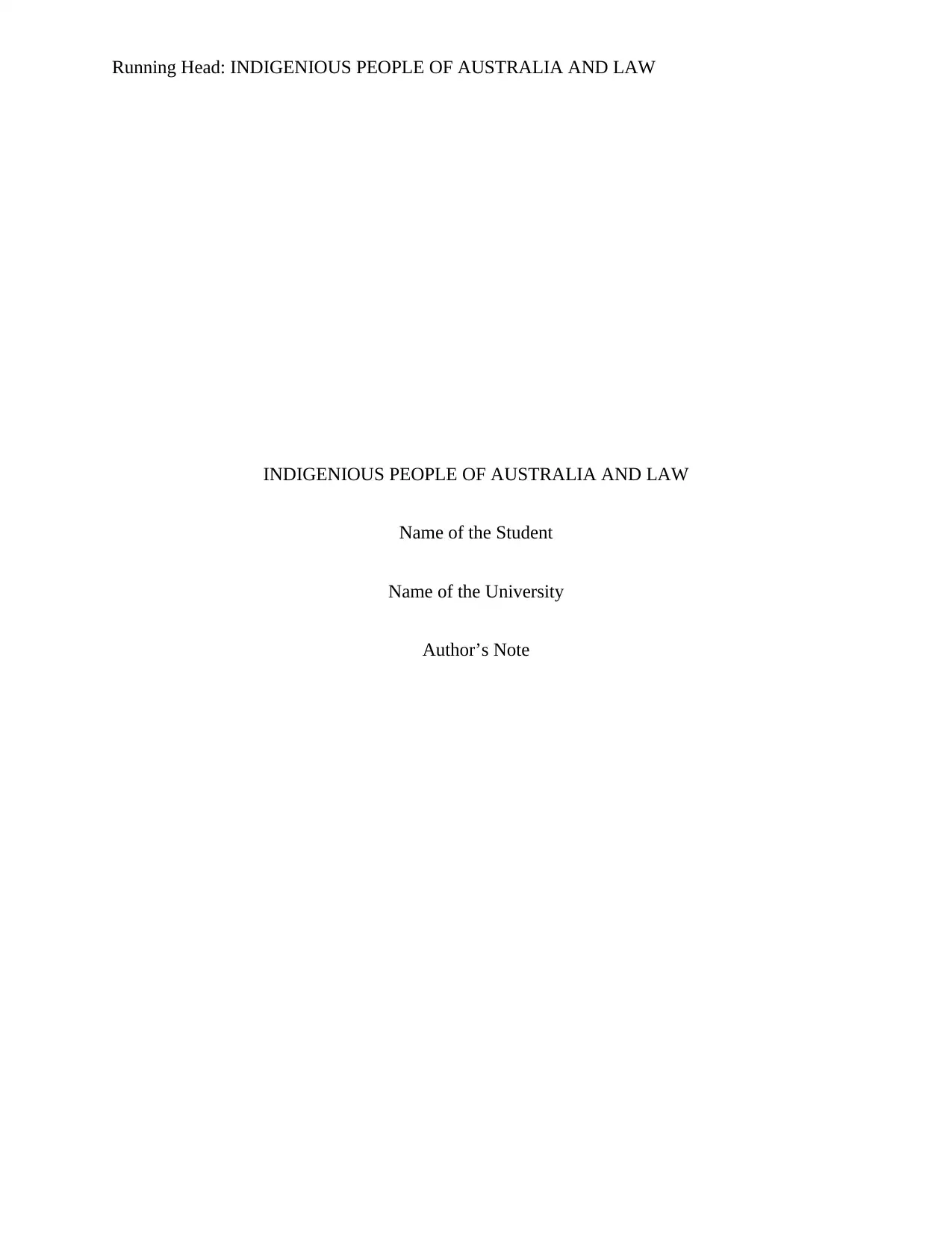
Running Head: INDIGENIOUS PEOPLE OF AUSTRALIA AND LAW
INDIGENIOUS PEOPLE OF AUSTRALIA AND LAW
Name of the Student
Name of the University
Author’s Note
INDIGENIOUS PEOPLE OF AUSTRALIA AND LAW
Name of the Student
Name of the University
Author’s Note
Paraphrase This Document
Need a fresh take? Get an instant paraphrase of this document with our AI Paraphraser
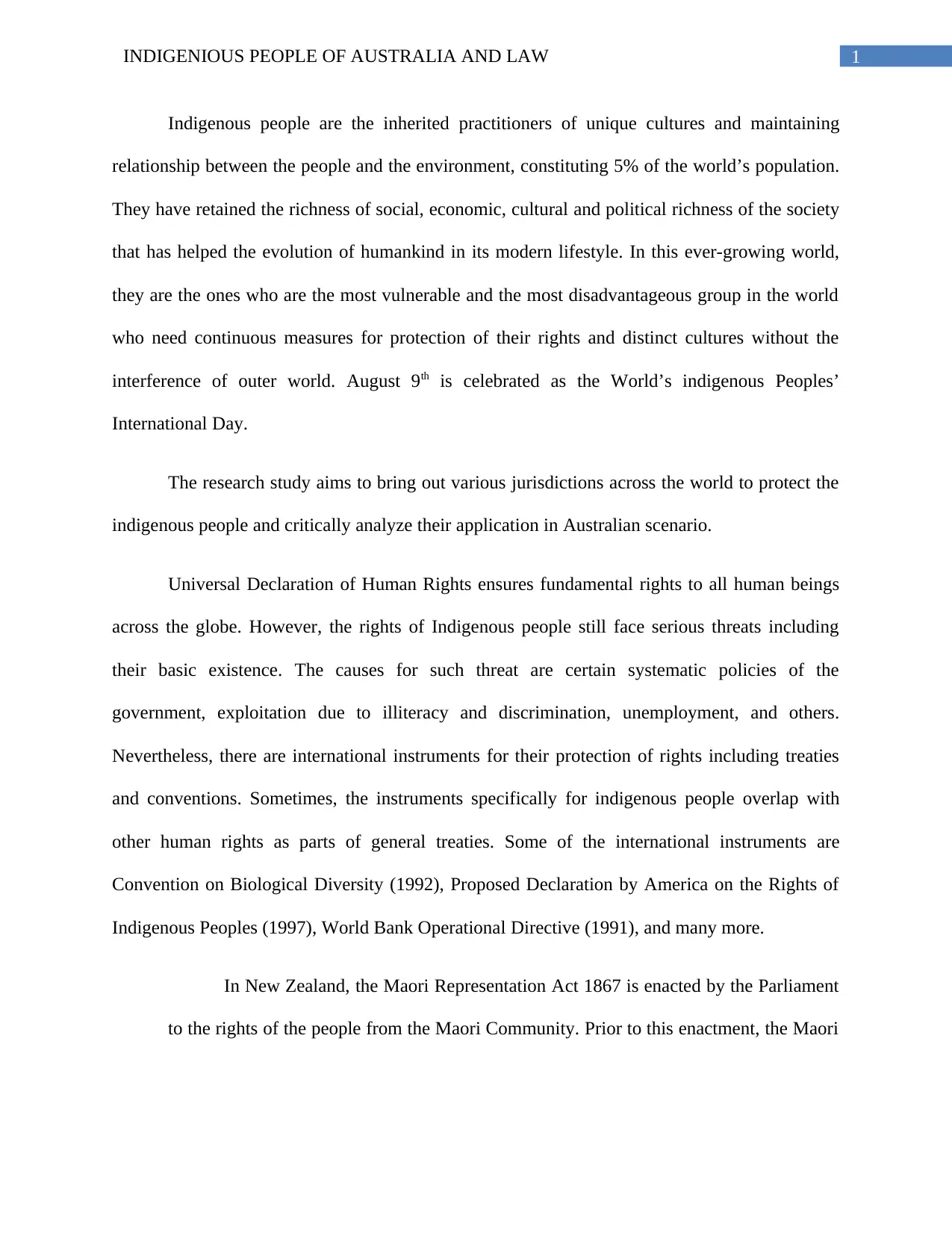
1INDIGENIOUS PEOPLE OF AUSTRALIA AND LAW
Indigenous people are the inherited practitioners of unique cultures and maintaining
relationship between the people and the environment, constituting 5% of the world’s population.
They have retained the richness of social, economic, cultural and political richness of the society
that has helped the evolution of humankind in its modern lifestyle. In this ever-growing world,
they are the ones who are the most vulnerable and the most disadvantageous group in the world
who need continuous measures for protection of their rights and distinct cultures without the
interference of outer world. August 9th is celebrated as the World’s indigenous Peoples’
International Day.
The research study aims to bring out various jurisdictions across the world to protect the
indigenous people and critically analyze their application in Australian scenario.
Universal Declaration of Human Rights ensures fundamental rights to all human beings
across the globe. However, the rights of Indigenous people still face serious threats including
their basic existence. The causes for such threat are certain systematic policies of the
government, exploitation due to illiteracy and discrimination, unemployment, and others.
Nevertheless, there are international instruments for their protection of rights including treaties
and conventions. Sometimes, the instruments specifically for indigenous people overlap with
other human rights as parts of general treaties. Some of the international instruments are
Convention on Biological Diversity (1992), Proposed Declaration by America on the Rights of
Indigenous Peoples (1997), World Bank Operational Directive (1991), and many more.
In New Zealand, the Maori Representation Act 1867 is enacted by the Parliament
to the rights of the people from the Maori Community. Prior to this enactment, the Maori
Indigenous people are the inherited practitioners of unique cultures and maintaining
relationship between the people and the environment, constituting 5% of the world’s population.
They have retained the richness of social, economic, cultural and political richness of the society
that has helped the evolution of humankind in its modern lifestyle. In this ever-growing world,
they are the ones who are the most vulnerable and the most disadvantageous group in the world
who need continuous measures for protection of their rights and distinct cultures without the
interference of outer world. August 9th is celebrated as the World’s indigenous Peoples’
International Day.
The research study aims to bring out various jurisdictions across the world to protect the
indigenous people and critically analyze their application in Australian scenario.
Universal Declaration of Human Rights ensures fundamental rights to all human beings
across the globe. However, the rights of Indigenous people still face serious threats including
their basic existence. The causes for such threat are certain systematic policies of the
government, exploitation due to illiteracy and discrimination, unemployment, and others.
Nevertheless, there are international instruments for their protection of rights including treaties
and conventions. Sometimes, the instruments specifically for indigenous people overlap with
other human rights as parts of general treaties. Some of the international instruments are
Convention on Biological Diversity (1992), Proposed Declaration by America on the Rights of
Indigenous Peoples (1997), World Bank Operational Directive (1991), and many more.
In New Zealand, the Maori Representation Act 1867 is enacted by the Parliament
to the rights of the people from the Maori Community. Prior to this enactment, the Maori
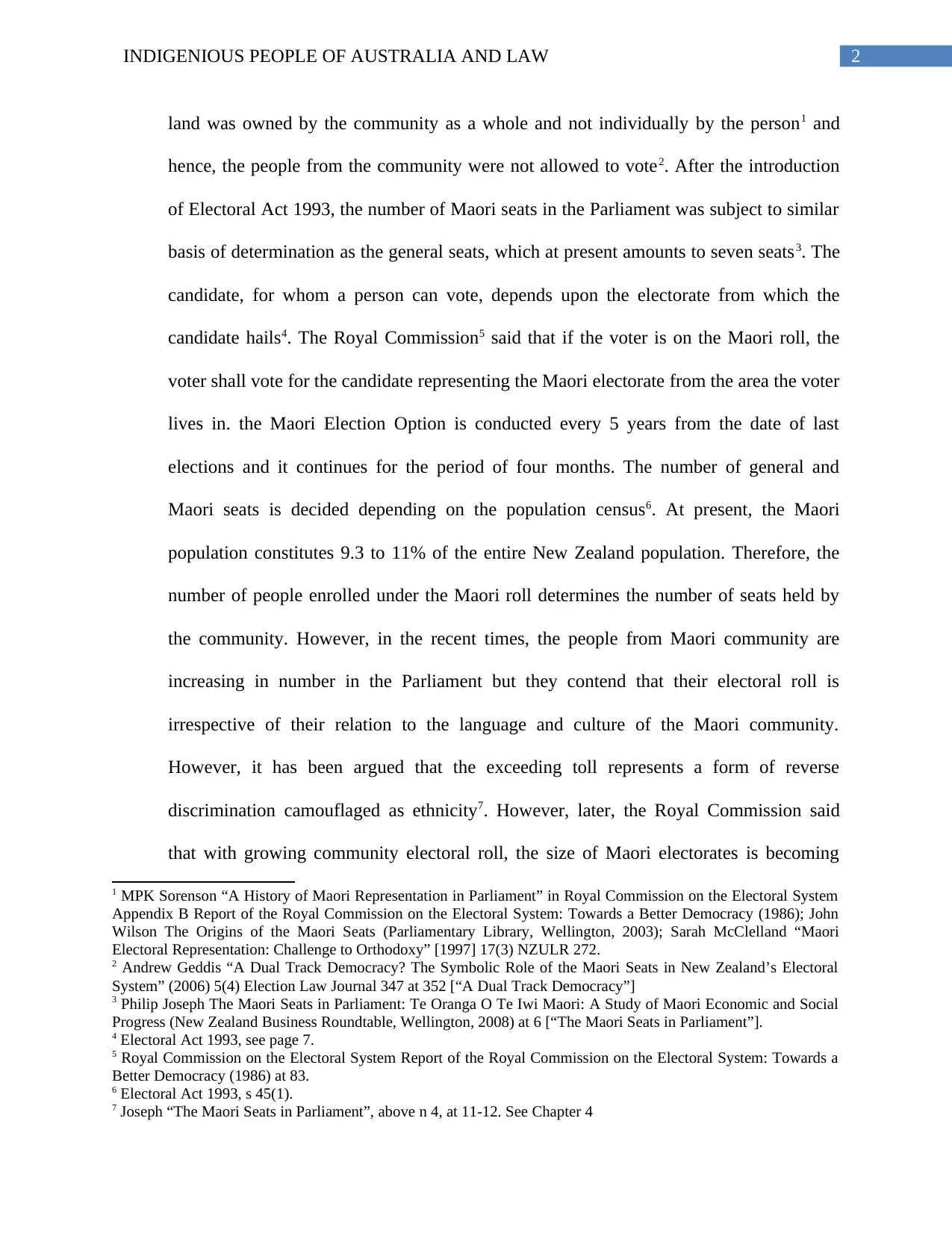
2INDIGENIOUS PEOPLE OF AUSTRALIA AND LAW
land was owned by the community as a whole and not individually by the person1 and
hence, the people from the community were not allowed to vote2. After the introduction
of Electoral Act 1993, the number of Maori seats in the Parliament was subject to similar
basis of determination as the general seats, which at present amounts to seven seats3. The
candidate, for whom a person can vote, depends upon the electorate from which the
candidate hails4. The Royal Commission5 said that if the voter is on the Maori roll, the
voter shall vote for the candidate representing the Maori electorate from the area the voter
lives in. the Maori Election Option is conducted every 5 years from the date of last
elections and it continues for the period of four months. The number of general and
Maori seats is decided depending on the population census6. At present, the Maori
population constitutes 9.3 to 11% of the entire New Zealand population. Therefore, the
number of people enrolled under the Maori roll determines the number of seats held by
the community. However, in the recent times, the people from Maori community are
increasing in number in the Parliament but they contend that their electoral roll is
irrespective of their relation to the language and culture of the Maori community.
However, it has been argued that the exceeding toll represents a form of reverse
discrimination camouflaged as ethnicity7. However, later, the Royal Commission said
that with growing community electoral roll, the size of Maori electorates is becoming
1 MPK Sorenson “A History of Maori Representation in Parliament” in Royal Commission on the Electoral System
Appendix B Report of the Royal Commission on the Electoral System: Towards a Better Democracy (1986); John
Wilson The Origins of the Maori Seats (Parliamentary Library, Wellington, 2003); Sarah McClelland “Maori
Electoral Representation: Challenge to Orthodoxy” [1997] 17(3) NZULR 272.
2 Andrew Geddis “A Dual Track Democracy? The Symbolic Role of the Maori Seats in New Zealand’s Electoral
System” (2006) 5(4) Election Law Journal 347 at 352 [“A Dual Track Democracy”]
3 Philip Joseph The Maori Seats in Parliament: Te Oranga O Te Iwi Maori: A Study of Maori Economic and Social
Progress (New Zealand Business Roundtable, Wellington, 2008) at 6 [“The Maori Seats in Parliament”].
4 Electoral Act 1993, see page 7.
5 Royal Commission on the Electoral System Report of the Royal Commission on the Electoral System: Towards a
Better Democracy (1986) at 83.
6 Electoral Act 1993, s 45(1).
7 Joseph “The Maori Seats in Parliament”, above n 4, at 11-12. See Chapter 4
land was owned by the community as a whole and not individually by the person1 and
hence, the people from the community were not allowed to vote2. After the introduction
of Electoral Act 1993, the number of Maori seats in the Parliament was subject to similar
basis of determination as the general seats, which at present amounts to seven seats3. The
candidate, for whom a person can vote, depends upon the electorate from which the
candidate hails4. The Royal Commission5 said that if the voter is on the Maori roll, the
voter shall vote for the candidate representing the Maori electorate from the area the voter
lives in. the Maori Election Option is conducted every 5 years from the date of last
elections and it continues for the period of four months. The number of general and
Maori seats is decided depending on the population census6. At present, the Maori
population constitutes 9.3 to 11% of the entire New Zealand population. Therefore, the
number of people enrolled under the Maori roll determines the number of seats held by
the community. However, in the recent times, the people from Maori community are
increasing in number in the Parliament but they contend that their electoral roll is
irrespective of their relation to the language and culture of the Maori community.
However, it has been argued that the exceeding toll represents a form of reverse
discrimination camouflaged as ethnicity7. However, later, the Royal Commission said
that with growing community electoral roll, the size of Maori electorates is becoming
1 MPK Sorenson “A History of Maori Representation in Parliament” in Royal Commission on the Electoral System
Appendix B Report of the Royal Commission on the Electoral System: Towards a Better Democracy (1986); John
Wilson The Origins of the Maori Seats (Parliamentary Library, Wellington, 2003); Sarah McClelland “Maori
Electoral Representation: Challenge to Orthodoxy” [1997] 17(3) NZULR 272.
2 Andrew Geddis “A Dual Track Democracy? The Symbolic Role of the Maori Seats in New Zealand’s Electoral
System” (2006) 5(4) Election Law Journal 347 at 352 [“A Dual Track Democracy”]
3 Philip Joseph The Maori Seats in Parliament: Te Oranga O Te Iwi Maori: A Study of Maori Economic and Social
Progress (New Zealand Business Roundtable, Wellington, 2008) at 6 [“The Maori Seats in Parliament”].
4 Electoral Act 1993, see page 7.
5 Royal Commission on the Electoral System Report of the Royal Commission on the Electoral System: Towards a
Better Democracy (1986) at 83.
6 Electoral Act 1993, s 45(1).
7 Joseph “The Maori Seats in Parliament”, above n 4, at 11-12. See Chapter 4
⊘ This is a preview!⊘
Do you want full access?
Subscribe today to unlock all pages.

Trusted by 1+ million students worldwide
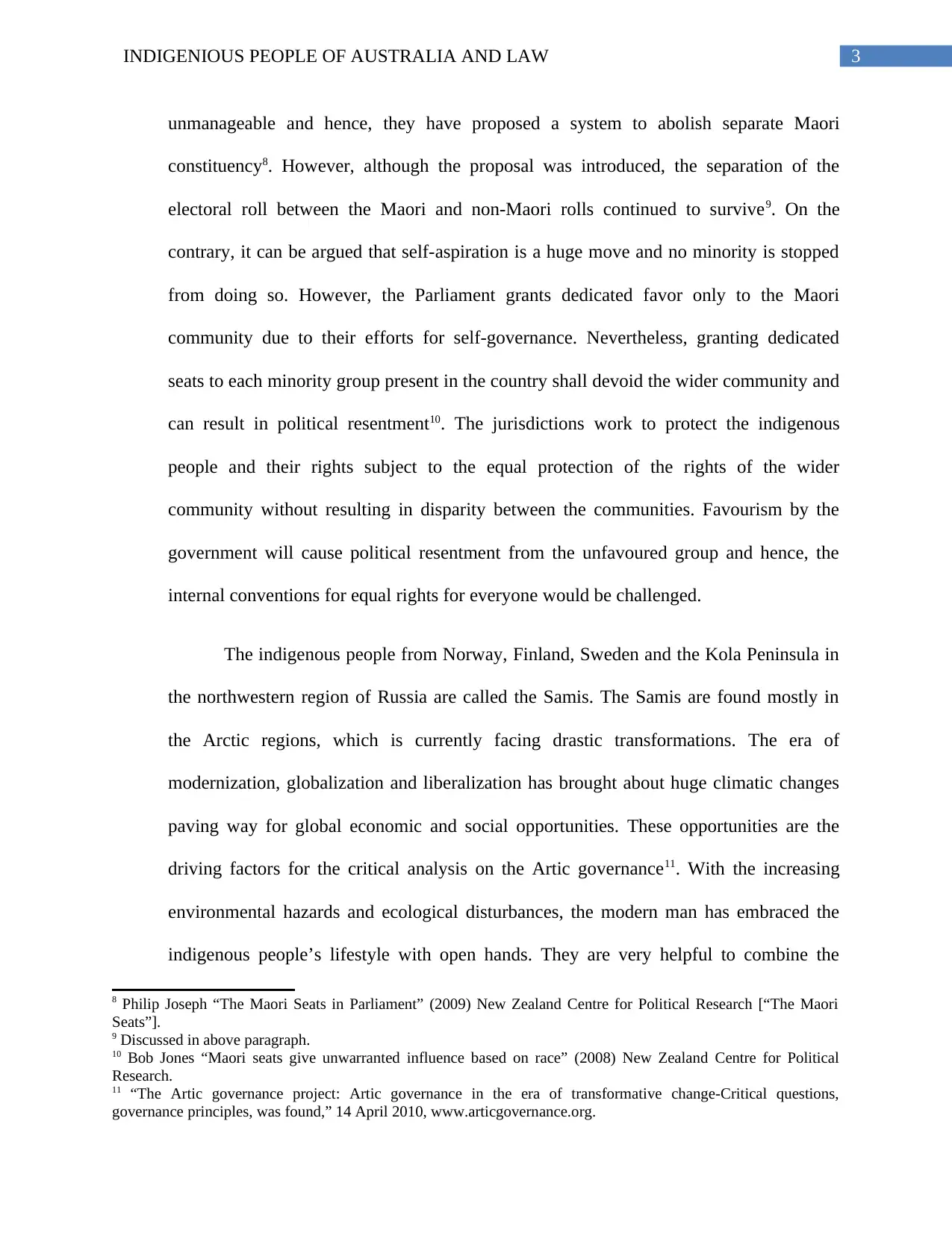
3INDIGENIOUS PEOPLE OF AUSTRALIA AND LAW
unmanageable and hence, they have proposed a system to abolish separate Maori
constituency8. However, although the proposal was introduced, the separation of the
electoral roll between the Maori and non-Maori rolls continued to survive9. On the
contrary, it can be argued that self-aspiration is a huge move and no minority is stopped
from doing so. However, the Parliament grants dedicated favor only to the Maori
community due to their efforts for self-governance. Nevertheless, granting dedicated
seats to each minority group present in the country shall devoid the wider community and
can result in political resentment10. The jurisdictions work to protect the indigenous
people and their rights subject to the equal protection of the rights of the wider
community without resulting in disparity between the communities. Favourism by the
government will cause political resentment from the unfavoured group and hence, the
internal conventions for equal rights for everyone would be challenged.
The indigenous people from Norway, Finland, Sweden and the Kola Peninsula in
the northwestern region of Russia are called the Samis. The Samis are found mostly in
the Arctic regions, which is currently facing drastic transformations. The era of
modernization, globalization and liberalization has brought about huge climatic changes
paving way for global economic and social opportunities. These opportunities are the
driving factors for the critical analysis on the Artic governance11. With the increasing
environmental hazards and ecological disturbances, the modern man has embraced the
indigenous people’s lifestyle with open hands. They are very helpful to combine the
8 Philip Joseph “The Maori Seats in Parliament” (2009) New Zealand Centre for Political Research [“The Maori
Seats”].
9 Discussed in above paragraph.
10 Bob Jones “Maori seats give unwarranted influence based on race” (2008) New Zealand Centre for Political
Research.
11 “The Artic governance project: Artic governance in the era of transformative change-Critical questions,
governance principles, was found,” 14 April 2010, www.articgovernance.org.
unmanageable and hence, they have proposed a system to abolish separate Maori
constituency8. However, although the proposal was introduced, the separation of the
electoral roll between the Maori and non-Maori rolls continued to survive9. On the
contrary, it can be argued that self-aspiration is a huge move and no minority is stopped
from doing so. However, the Parliament grants dedicated favor only to the Maori
community due to their efforts for self-governance. Nevertheless, granting dedicated
seats to each minority group present in the country shall devoid the wider community and
can result in political resentment10. The jurisdictions work to protect the indigenous
people and their rights subject to the equal protection of the rights of the wider
community without resulting in disparity between the communities. Favourism by the
government will cause political resentment from the unfavoured group and hence, the
internal conventions for equal rights for everyone would be challenged.
The indigenous people from Norway, Finland, Sweden and the Kola Peninsula in
the northwestern region of Russia are called the Samis. The Samis are found mostly in
the Arctic regions, which is currently facing drastic transformations. The era of
modernization, globalization and liberalization has brought about huge climatic changes
paving way for global economic and social opportunities. These opportunities are the
driving factors for the critical analysis on the Artic governance11. With the increasing
environmental hazards and ecological disturbances, the modern man has embraced the
indigenous people’s lifestyle with open hands. They are very helpful to combine the
8 Philip Joseph “The Maori Seats in Parliament” (2009) New Zealand Centre for Political Research [“The Maori
Seats”].
9 Discussed in above paragraph.
10 Bob Jones “Maori seats give unwarranted influence based on race” (2008) New Zealand Centre for Political
Research.
11 “The Artic governance project: Artic governance in the era of transformative change-Critical questions,
governance principles, was found,” 14 April 2010, www.articgovernance.org.
Paraphrase This Document
Need a fresh take? Get an instant paraphrase of this document with our AI Paraphraser
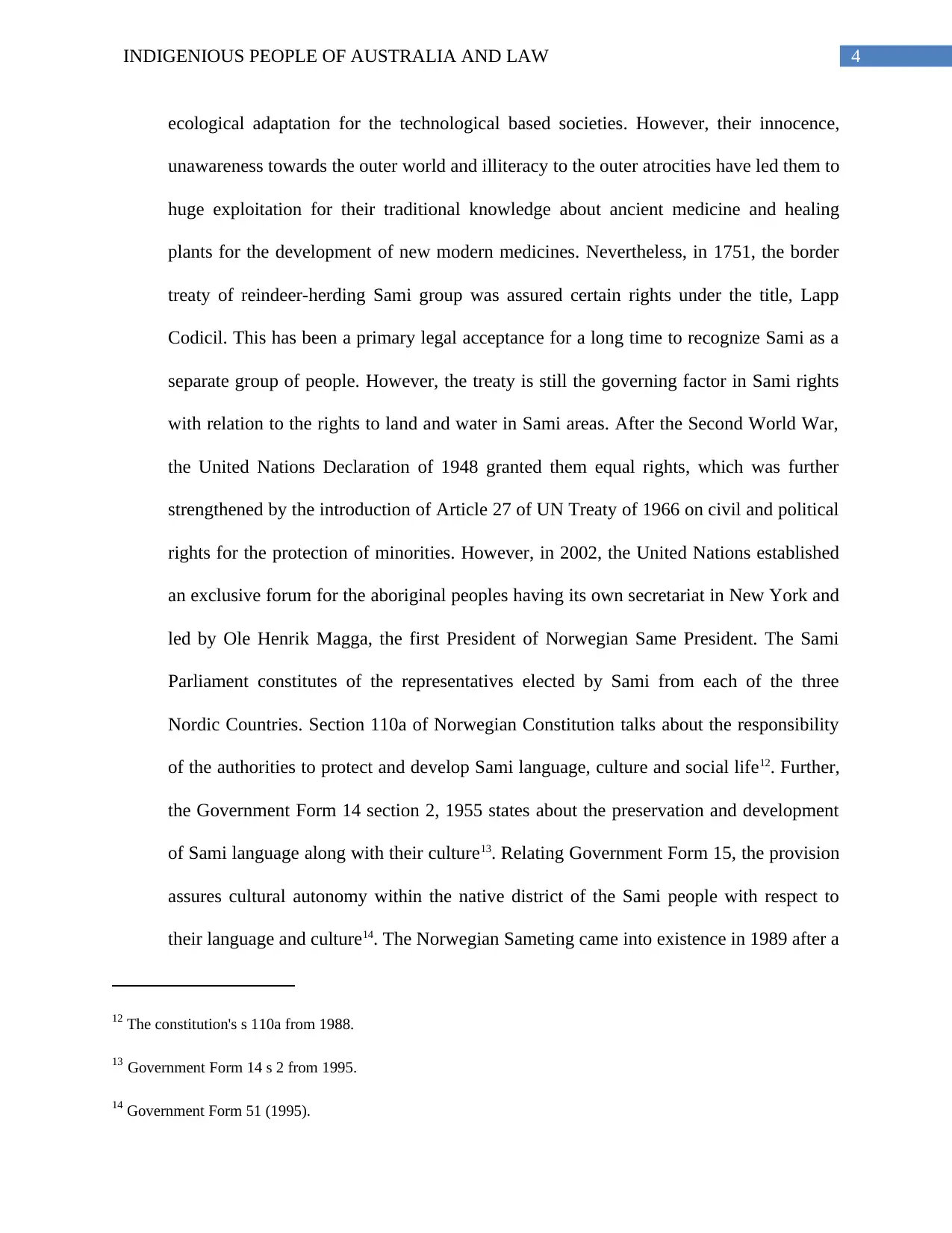
4INDIGENIOUS PEOPLE OF AUSTRALIA AND LAW
ecological adaptation for the technological based societies. However, their innocence,
unawareness towards the outer world and illiteracy to the outer atrocities have led them to
huge exploitation for their traditional knowledge about ancient medicine and healing
plants for the development of new modern medicines. Nevertheless, in 1751, the border
treaty of reindeer-herding Sami group was assured certain rights under the title, Lapp
Codicil. This has been a primary legal acceptance for a long time to recognize Sami as a
separate group of people. However, the treaty is still the governing factor in Sami rights
with relation to the rights to land and water in Sami areas. After the Second World War,
the United Nations Declaration of 1948 granted them equal rights, which was further
strengthened by the introduction of Article 27 of UN Treaty of 1966 on civil and political
rights for the protection of minorities. However, in 2002, the United Nations established
an exclusive forum for the aboriginal peoples having its own secretariat in New York and
led by Ole Henrik Magga, the first President of Norwegian Same President. The Sami
Parliament constitutes of the representatives elected by Sami from each of the three
Nordic Countries. Section 110a of Norwegian Constitution talks about the responsibility
of the authorities to protect and develop Sami language, culture and social life12. Further,
the Government Form 14 section 2, 1955 states about the preservation and development
of Sami language along with their culture13. Relating Government Form 15, the provision
assures cultural autonomy within the native district of the Sami people with respect to
their language and culture14. The Norwegian Sameting came into existence in 1989 after a
12 The constitution's s 110a from 1988.
13 Government Form 14 s 2 from 1995.
14 Government Form 51 (1995).
ecological adaptation for the technological based societies. However, their innocence,
unawareness towards the outer world and illiteracy to the outer atrocities have led them to
huge exploitation for their traditional knowledge about ancient medicine and healing
plants for the development of new modern medicines. Nevertheless, in 1751, the border
treaty of reindeer-herding Sami group was assured certain rights under the title, Lapp
Codicil. This has been a primary legal acceptance for a long time to recognize Sami as a
separate group of people. However, the treaty is still the governing factor in Sami rights
with relation to the rights to land and water in Sami areas. After the Second World War,
the United Nations Declaration of 1948 granted them equal rights, which was further
strengthened by the introduction of Article 27 of UN Treaty of 1966 on civil and political
rights for the protection of minorities. However, in 2002, the United Nations established
an exclusive forum for the aboriginal peoples having its own secretariat in New York and
led by Ole Henrik Magga, the first President of Norwegian Same President. The Sami
Parliament constitutes of the representatives elected by Sami from each of the three
Nordic Countries. Section 110a of Norwegian Constitution talks about the responsibility
of the authorities to protect and develop Sami language, culture and social life12. Further,
the Government Form 14 section 2, 1955 states about the preservation and development
of Sami language along with their culture13. Relating Government Form 15, the provision
assures cultural autonomy within the native district of the Sami people with respect to
their language and culture14. The Norwegian Sameting came into existence in 1989 after a
12 The constitution's s 110a from 1988.
13 Government Form 14 s 2 from 1995.
14 Government Form 51 (1995).
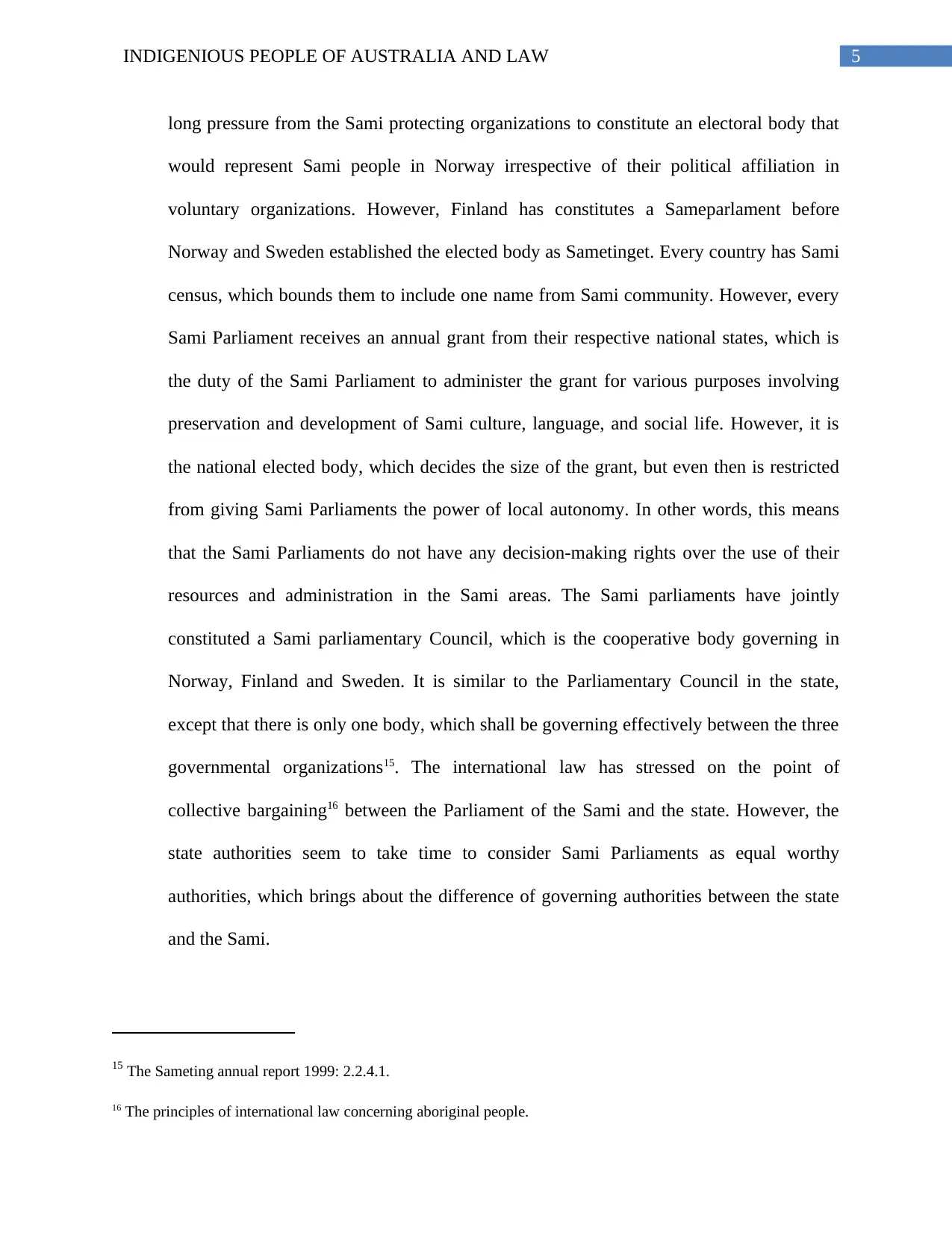
5INDIGENIOUS PEOPLE OF AUSTRALIA AND LAW
long pressure from the Sami protecting organizations to constitute an electoral body that
would represent Sami people in Norway irrespective of their political affiliation in
voluntary organizations. However, Finland has constitutes a Sameparlament before
Norway and Sweden established the elected body as Sametinget. Every country has Sami
census, which bounds them to include one name from Sami community. However, every
Sami Parliament receives an annual grant from their respective national states, which is
the duty of the Sami Parliament to administer the grant for various purposes involving
preservation and development of Sami culture, language, and social life. However, it is
the national elected body, which decides the size of the grant, but even then is restricted
from giving Sami Parliaments the power of local autonomy. In other words, this means
that the Sami Parliaments do not have any decision-making rights over the use of their
resources and administration in the Sami areas. The Sami parliaments have jointly
constituted a Sami parliamentary Council, which is the cooperative body governing in
Norway, Finland and Sweden. It is similar to the Parliamentary Council in the state,
except that there is only one body, which shall be governing effectively between the three
governmental organizations15. The international law has stressed on the point of
collective bargaining16 between the Parliament of the Sami and the state. However, the
state authorities seem to take time to consider Sami Parliaments as equal worthy
authorities, which brings about the difference of governing authorities between the state
and the Sami.
15 The Sameting annual report 1999: 2.2.4.1.
16 The principles of international law concerning aboriginal people.
long pressure from the Sami protecting organizations to constitute an electoral body that
would represent Sami people in Norway irrespective of their political affiliation in
voluntary organizations. However, Finland has constitutes a Sameparlament before
Norway and Sweden established the elected body as Sametinget. Every country has Sami
census, which bounds them to include one name from Sami community. However, every
Sami Parliament receives an annual grant from their respective national states, which is
the duty of the Sami Parliament to administer the grant for various purposes involving
preservation and development of Sami culture, language, and social life. However, it is
the national elected body, which decides the size of the grant, but even then is restricted
from giving Sami Parliaments the power of local autonomy. In other words, this means
that the Sami Parliaments do not have any decision-making rights over the use of their
resources and administration in the Sami areas. The Sami parliaments have jointly
constituted a Sami parliamentary Council, which is the cooperative body governing in
Norway, Finland and Sweden. It is similar to the Parliamentary Council in the state,
except that there is only one body, which shall be governing effectively between the three
governmental organizations15. The international law has stressed on the point of
collective bargaining16 between the Parliament of the Sami and the state. However, the
state authorities seem to take time to consider Sami Parliaments as equal worthy
authorities, which brings about the difference of governing authorities between the state
and the Sami.
15 The Sameting annual report 1999: 2.2.4.1.
16 The principles of international law concerning aboriginal people.
⊘ This is a preview!⊘
Do you want full access?
Subscribe today to unlock all pages.

Trusted by 1+ million students worldwide
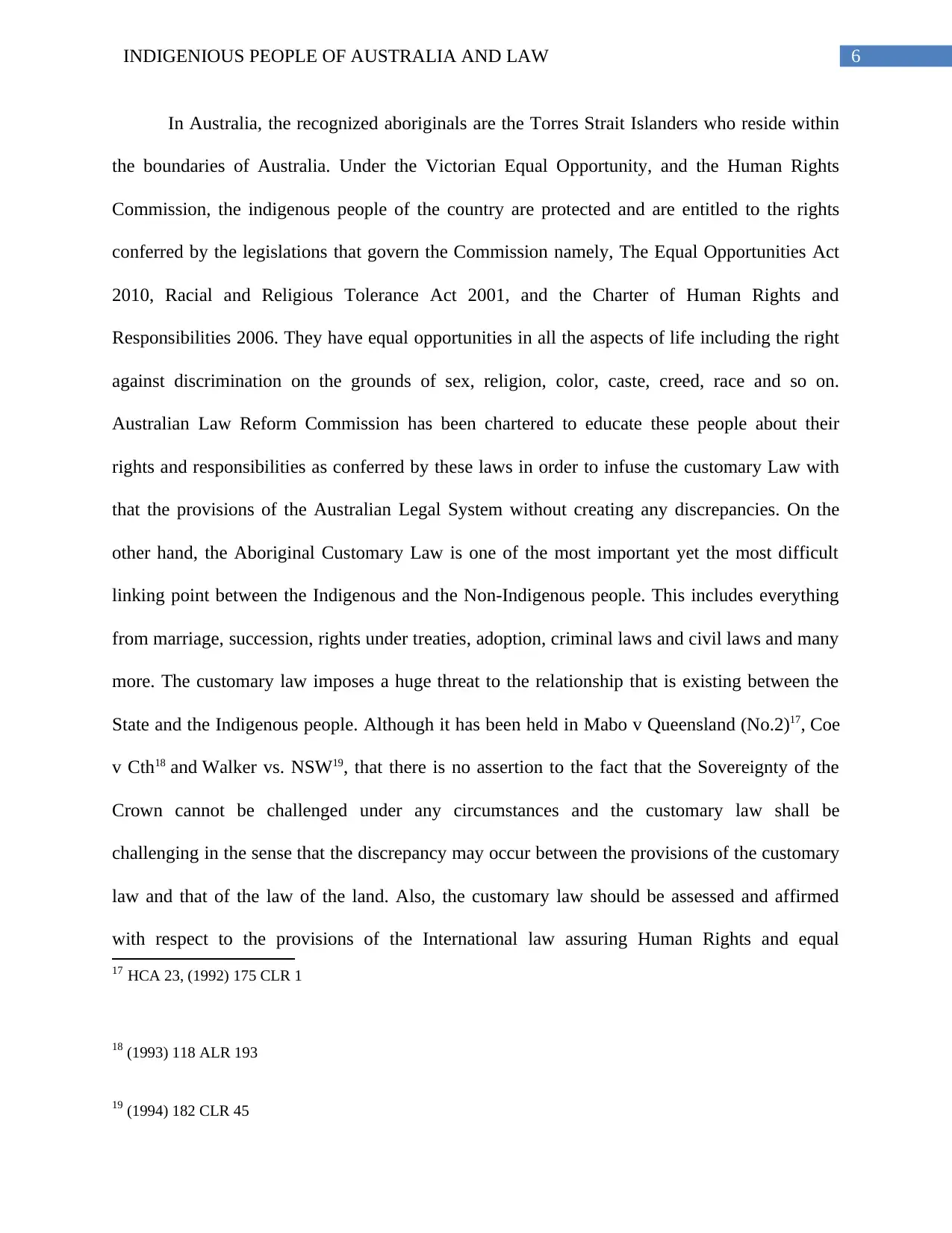
6INDIGENIOUS PEOPLE OF AUSTRALIA AND LAW
In Australia, the recognized aboriginals are the Torres Strait Islanders who reside within
the boundaries of Australia. Under the Victorian Equal Opportunity, and the Human Rights
Commission, the indigenous people of the country are protected and are entitled to the rights
conferred by the legislations that govern the Commission namely, The Equal Opportunities Act
2010, Racial and Religious Tolerance Act 2001, and the Charter of Human Rights and
Responsibilities 2006. They have equal opportunities in all the aspects of life including the right
against discrimination on the grounds of sex, religion, color, caste, creed, race and so on.
Australian Law Reform Commission has been chartered to educate these people about their
rights and responsibilities as conferred by these laws in order to infuse the customary Law with
that the provisions of the Australian Legal System without creating any discrepancies. On the
other hand, the Aboriginal Customary Law is one of the most important yet the most difficult
linking point between the Indigenous and the Non-Indigenous people. This includes everything
from marriage, succession, rights under treaties, adoption, criminal laws and civil laws and many
more. The customary law imposes a huge threat to the relationship that is existing between the
State and the Indigenous people. Although it has been held in Mabo v Queensland (No.2)17, Coe
v Cth18 and Walker vs. NSW19, that there is no assertion to the fact that the Sovereignty of the
Crown cannot be challenged under any circumstances and the customary law shall be
challenging in the sense that the discrepancy may occur between the provisions of the customary
law and that of the law of the land. Also, the customary law should be assessed and affirmed
with respect to the provisions of the International law assuring Human Rights and equal
17 HCA 23, (1992) 175 CLR 1
18 (1993) 118 ALR 193
19 (1994) 182 CLR 45
In Australia, the recognized aboriginals are the Torres Strait Islanders who reside within
the boundaries of Australia. Under the Victorian Equal Opportunity, and the Human Rights
Commission, the indigenous people of the country are protected and are entitled to the rights
conferred by the legislations that govern the Commission namely, The Equal Opportunities Act
2010, Racial and Religious Tolerance Act 2001, and the Charter of Human Rights and
Responsibilities 2006. They have equal opportunities in all the aspects of life including the right
against discrimination on the grounds of sex, religion, color, caste, creed, race and so on.
Australian Law Reform Commission has been chartered to educate these people about their
rights and responsibilities as conferred by these laws in order to infuse the customary Law with
that the provisions of the Australian Legal System without creating any discrepancies. On the
other hand, the Aboriginal Customary Law is one of the most important yet the most difficult
linking point between the Indigenous and the Non-Indigenous people. This includes everything
from marriage, succession, rights under treaties, adoption, criminal laws and civil laws and many
more. The customary law imposes a huge threat to the relationship that is existing between the
State and the Indigenous people. Although it has been held in Mabo v Queensland (No.2)17, Coe
v Cth18 and Walker vs. NSW19, that there is no assertion to the fact that the Sovereignty of the
Crown cannot be challenged under any circumstances and the customary law shall be
challenging in the sense that the discrepancy may occur between the provisions of the customary
law and that of the law of the land. Also, the customary law should be assessed and affirmed
with respect to the provisions of the International law assuring Human Rights and equal
17 HCA 23, (1992) 175 CLR 1
18 (1993) 118 ALR 193
19 (1994) 182 CLR 45
Paraphrase This Document
Need a fresh take? Get an instant paraphrase of this document with our AI Paraphraser
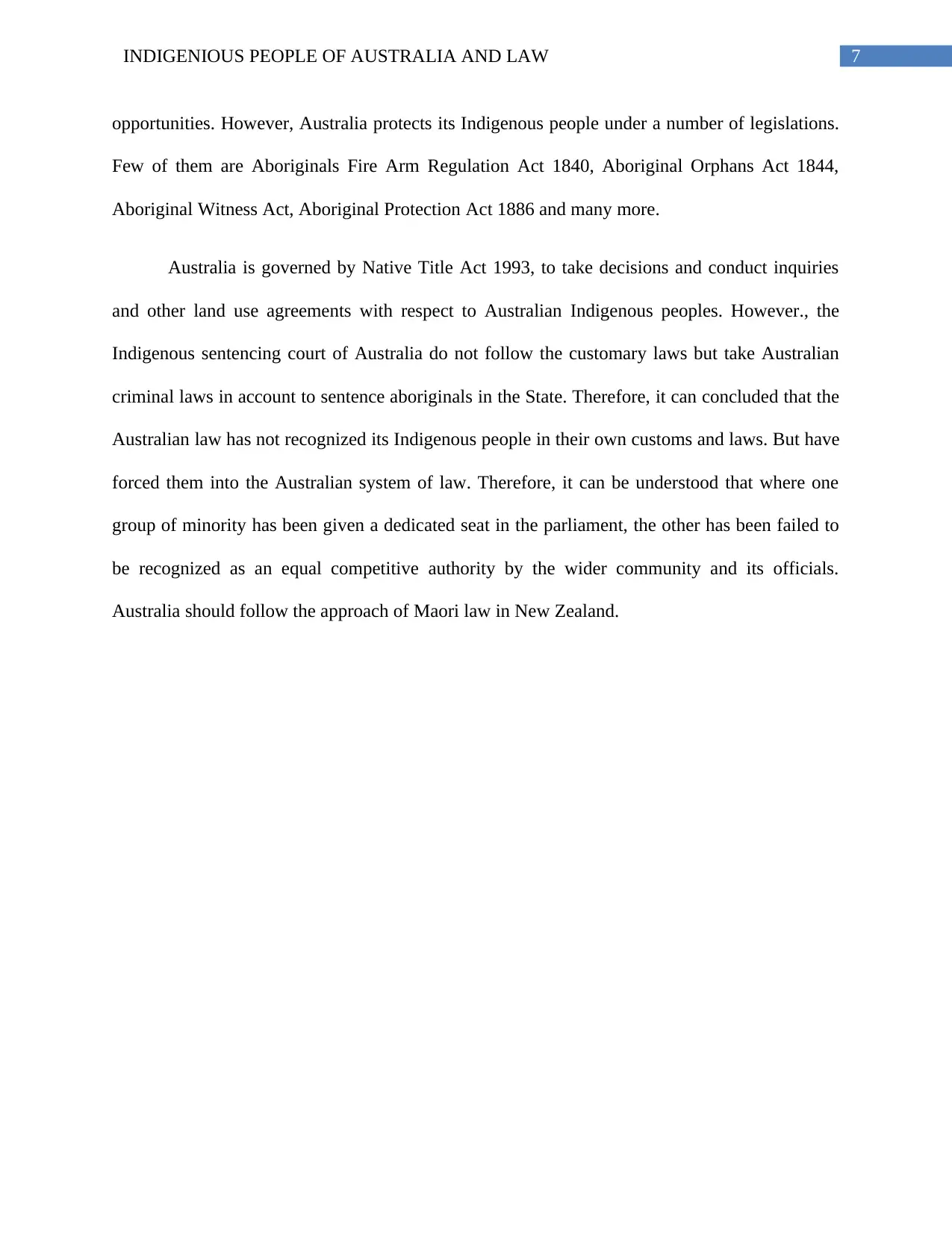
7INDIGENIOUS PEOPLE OF AUSTRALIA AND LAW
opportunities. However, Australia protects its Indigenous people under a number of legislations.
Few of them are Aboriginals Fire Arm Regulation Act 1840, Aboriginal Orphans Act 1844,
Aboriginal Witness Act, Aboriginal Protection Act 1886 and many more.
Australia is governed by Native Title Act 1993, to take decisions and conduct inquiries
and other land use agreements with respect to Australian Indigenous peoples. However., the
Indigenous sentencing court of Australia do not follow the customary laws but take Australian
criminal laws in account to sentence aboriginals in the State. Therefore, it can concluded that the
Australian law has not recognized its Indigenous people in their own customs and laws. But have
forced them into the Australian system of law. Therefore, it can be understood that where one
group of minority has been given a dedicated seat in the parliament, the other has been failed to
be recognized as an equal competitive authority by the wider community and its officials.
Australia should follow the approach of Maori law in New Zealand.
opportunities. However, Australia protects its Indigenous people under a number of legislations.
Few of them are Aboriginals Fire Arm Regulation Act 1840, Aboriginal Orphans Act 1844,
Aboriginal Witness Act, Aboriginal Protection Act 1886 and many more.
Australia is governed by Native Title Act 1993, to take decisions and conduct inquiries
and other land use agreements with respect to Australian Indigenous peoples. However., the
Indigenous sentencing court of Australia do not follow the customary laws but take Australian
criminal laws in account to sentence aboriginals in the State. Therefore, it can concluded that the
Australian law has not recognized its Indigenous people in their own customs and laws. But have
forced them into the Australian system of law. Therefore, it can be understood that where one
group of minority has been given a dedicated seat in the parliament, the other has been failed to
be recognized as an equal competitive authority by the wider community and its officials.
Australia should follow the approach of Maori law in New Zealand.
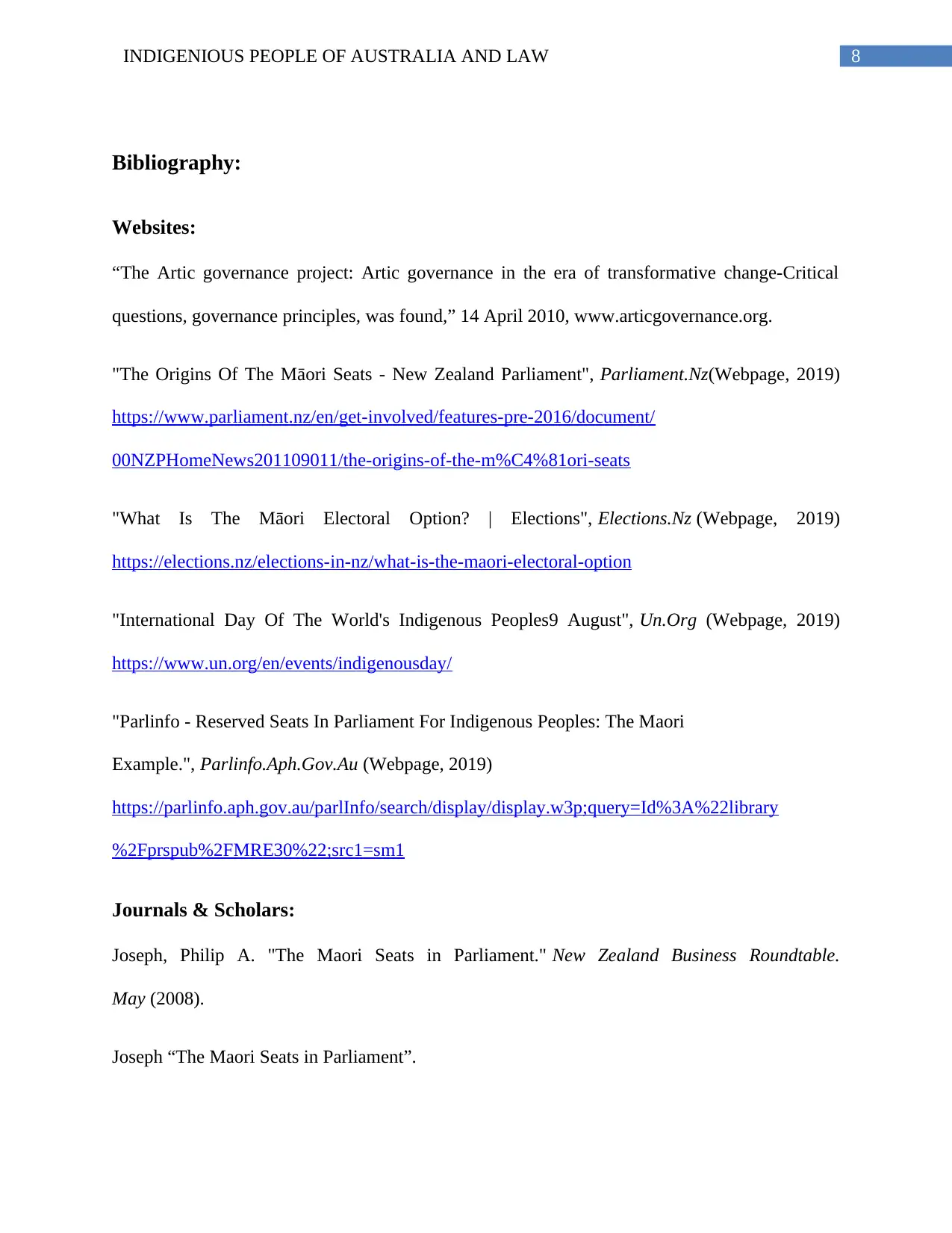
8INDIGENIOUS PEOPLE OF AUSTRALIA AND LAW
Bibliography:
Websites:
“The Artic governance project: Artic governance in the era of transformative change-Critical
questions, governance principles, was found,” 14 April 2010, www.articgovernance.org.
"The Origins Of The Māori Seats - New Zealand Parliament", Parliament.Nz(Webpage, 2019)
https://www.parliament.nz/en/get-involved/features-pre-2016/document/
00NZPHomeNews201109011/the-origins-of-the-m%C4%81ori-seats
"What Is The Māori Electoral Option? | Elections", Elections.Nz (Webpage, 2019)
https://elections.nz/elections-in-nz/what-is-the-maori-electoral-option
"International Day Of The World's Indigenous Peoples9 August", Un.Org (Webpage, 2019)
https://www.un.org/en/events/indigenousday/
"Parlinfo - Reserved Seats In Parliament For Indigenous Peoples: The Maori
Example.", Parlinfo.Aph.Gov.Au (Webpage, 2019)
https://parlinfo.aph.gov.au/parlInfo/search/display/display.w3p;query=Id%3A%22library
%2Fprspub%2FMRE30%22;src1=sm1
Journals & Scholars:
Joseph, Philip A. "The Maori Seats in Parliament." New Zealand Business Roundtable.
May (2008).
Joseph “The Maori Seats in Parliament”.
Bibliography:
Websites:
“The Artic governance project: Artic governance in the era of transformative change-Critical
questions, governance principles, was found,” 14 April 2010, www.articgovernance.org.
"The Origins Of The Māori Seats - New Zealand Parliament", Parliament.Nz(Webpage, 2019)
https://www.parliament.nz/en/get-involved/features-pre-2016/document/
00NZPHomeNews201109011/the-origins-of-the-m%C4%81ori-seats
"What Is The Māori Electoral Option? | Elections", Elections.Nz (Webpage, 2019)
https://elections.nz/elections-in-nz/what-is-the-maori-electoral-option
"International Day Of The World's Indigenous Peoples9 August", Un.Org (Webpage, 2019)
https://www.un.org/en/events/indigenousday/
"Parlinfo - Reserved Seats In Parliament For Indigenous Peoples: The Maori
Example.", Parlinfo.Aph.Gov.Au (Webpage, 2019)
https://parlinfo.aph.gov.au/parlInfo/search/display/display.w3p;query=Id%3A%22library
%2Fprspub%2FMRE30%22;src1=sm1
Journals & Scholars:
Joseph, Philip A. "The Maori Seats in Parliament." New Zealand Business Roundtable.
May (2008).
Joseph “The Maori Seats in Parliament”.
⊘ This is a preview!⊘
Do you want full access?
Subscribe today to unlock all pages.

Trusted by 1+ million students worldwide
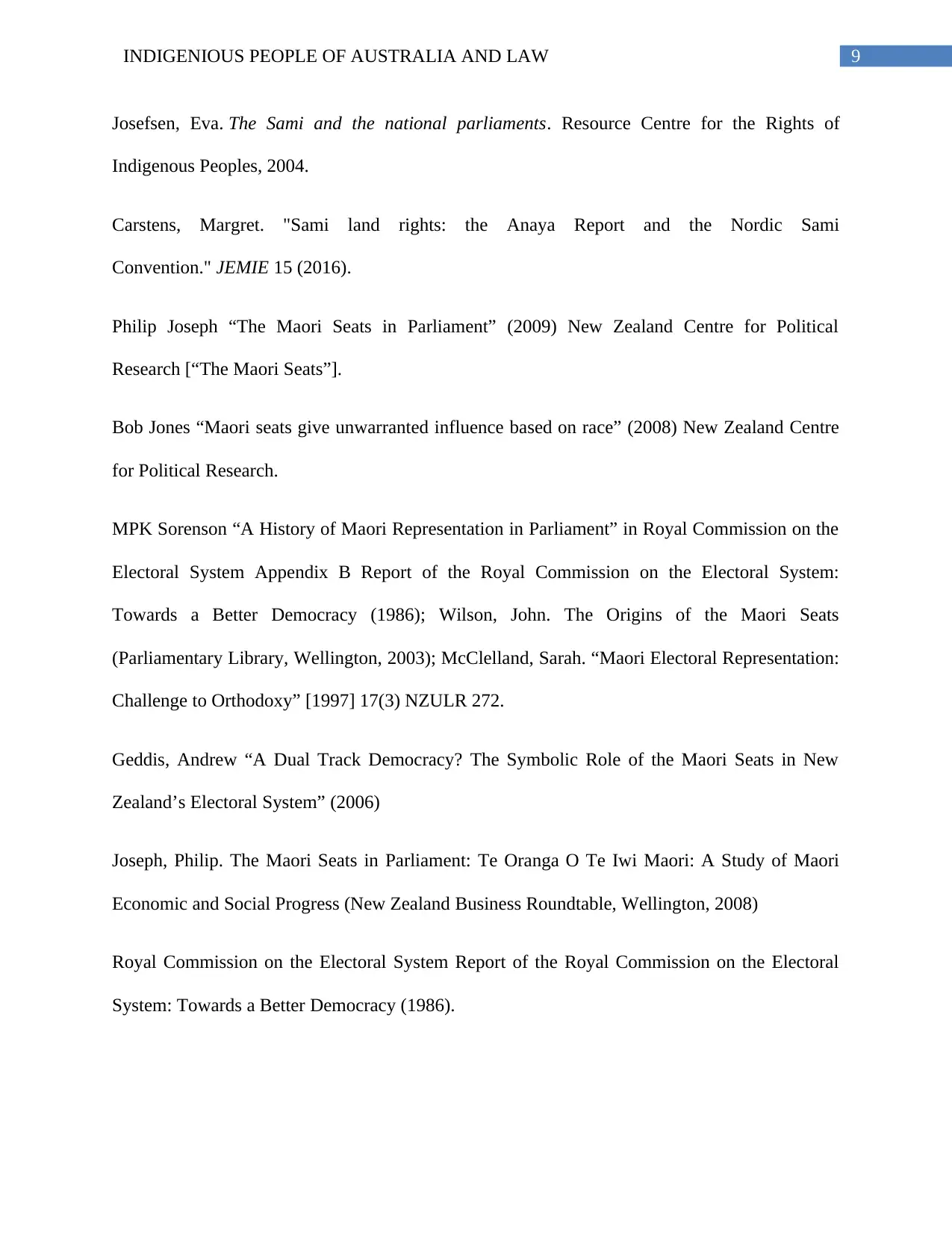
9INDIGENIOUS PEOPLE OF AUSTRALIA AND LAW
Josefsen, Eva. The Sami and the national parliaments. Resource Centre for the Rights of
Indigenous Peoples, 2004.
Carstens, Margret. "Sami land rights: the Anaya Report and the Nordic Sami
Convention." JEMIE 15 (2016).
Philip Joseph “The Maori Seats in Parliament” (2009) New Zealand Centre for Political
Research [“The Maori Seats”].
Bob Jones “Maori seats give unwarranted influence based on race” (2008) New Zealand Centre
for Political Research.
MPK Sorenson “A History of Maori Representation in Parliament” in Royal Commission on the
Electoral System Appendix B Report of the Royal Commission on the Electoral System:
Towards a Better Democracy (1986); Wilson, John. The Origins of the Maori Seats
(Parliamentary Library, Wellington, 2003); McClelland, Sarah. “Maori Electoral Representation:
Challenge to Orthodoxy” [1997] 17(3) NZULR 272.
Geddis, Andrew “A Dual Track Democracy? The Symbolic Role of the Maori Seats in New
Zealand’s Electoral System” (2006)
Joseph, Philip. The Maori Seats in Parliament: Te Oranga O Te Iwi Maori: A Study of Maori
Economic and Social Progress (New Zealand Business Roundtable, Wellington, 2008)
Royal Commission on the Electoral System Report of the Royal Commission on the Electoral
System: Towards a Better Democracy (1986).
Josefsen, Eva. The Sami and the national parliaments. Resource Centre for the Rights of
Indigenous Peoples, 2004.
Carstens, Margret. "Sami land rights: the Anaya Report and the Nordic Sami
Convention." JEMIE 15 (2016).
Philip Joseph “The Maori Seats in Parliament” (2009) New Zealand Centre for Political
Research [“The Maori Seats”].
Bob Jones “Maori seats give unwarranted influence based on race” (2008) New Zealand Centre
for Political Research.
MPK Sorenson “A History of Maori Representation in Parliament” in Royal Commission on the
Electoral System Appendix B Report of the Royal Commission on the Electoral System:
Towards a Better Democracy (1986); Wilson, John. The Origins of the Maori Seats
(Parliamentary Library, Wellington, 2003); McClelland, Sarah. “Maori Electoral Representation:
Challenge to Orthodoxy” [1997] 17(3) NZULR 272.
Geddis, Andrew “A Dual Track Democracy? The Symbolic Role of the Maori Seats in New
Zealand’s Electoral System” (2006)
Joseph, Philip. The Maori Seats in Parliament: Te Oranga O Te Iwi Maori: A Study of Maori
Economic and Social Progress (New Zealand Business Roundtable, Wellington, 2008)
Royal Commission on the Electoral System Report of the Royal Commission on the Electoral
System: Towards a Better Democracy (1986).
Paraphrase This Document
Need a fresh take? Get an instant paraphrase of this document with our AI Paraphraser
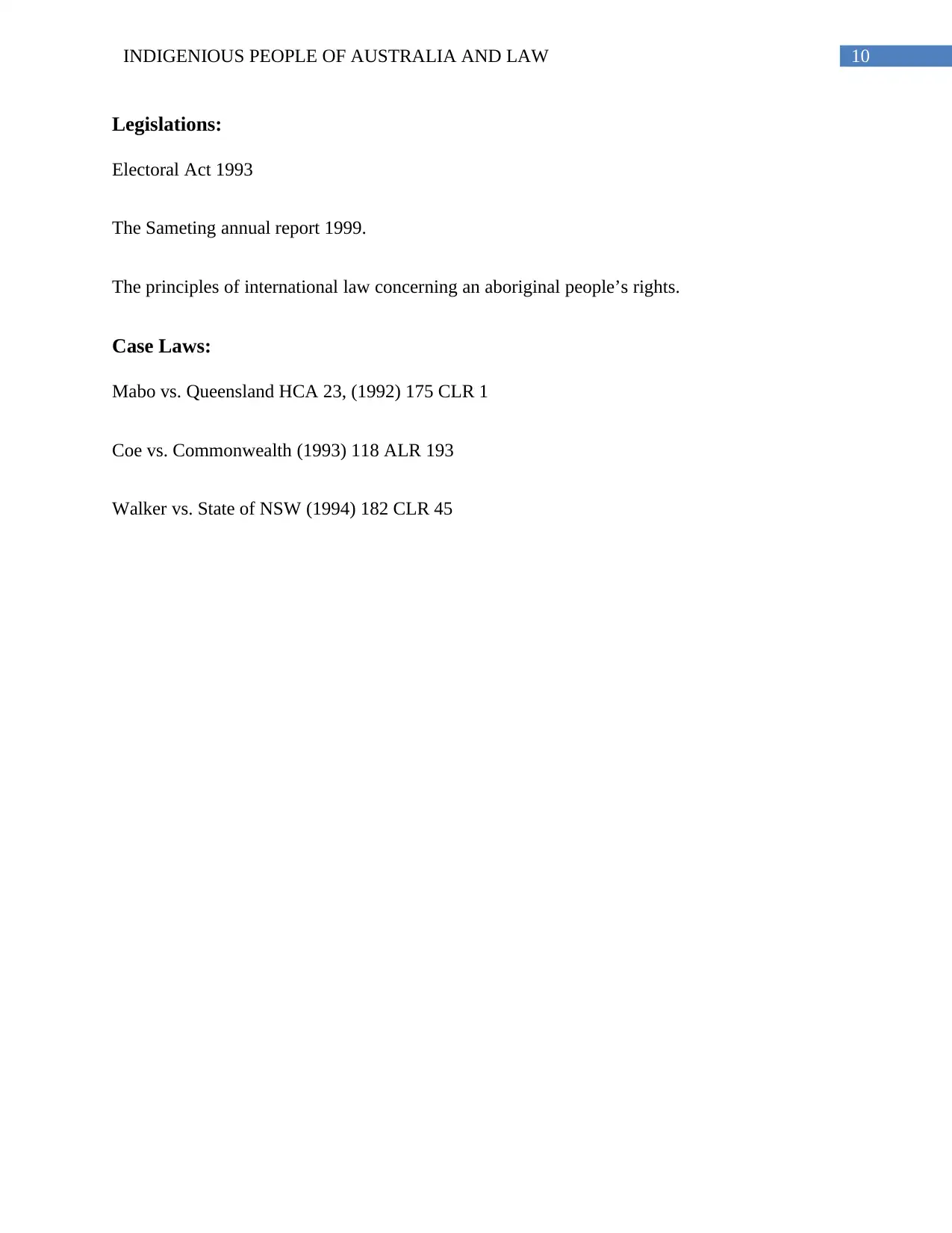
10INDIGENIOUS PEOPLE OF AUSTRALIA AND LAW
Legislations:
Electoral Act 1993
The Sameting annual report 1999.
The principles of international law concerning an aboriginal people’s rights.
Case Laws:
Mabo vs. Queensland HCA 23, (1992) 175 CLR 1
Coe vs. Commonwealth (1993) 118 ALR 193
Walker vs. State of NSW (1994) 182 CLR 45
Legislations:
Electoral Act 1993
The Sameting annual report 1999.
The principles of international law concerning an aboriginal people’s rights.
Case Laws:
Mabo vs. Queensland HCA 23, (1992) 175 CLR 1
Coe vs. Commonwealth (1993) 118 ALR 193
Walker vs. State of NSW (1994) 182 CLR 45
1 out of 11
Your All-in-One AI-Powered Toolkit for Academic Success.
+13062052269
info@desklib.com
Available 24*7 on WhatsApp / Email
![[object Object]](/_next/static/media/star-bottom.7253800d.svg)
Unlock your academic potential
Copyright © 2020–2025 A2Z Services. All Rights Reserved. Developed and managed by ZUCOL.

